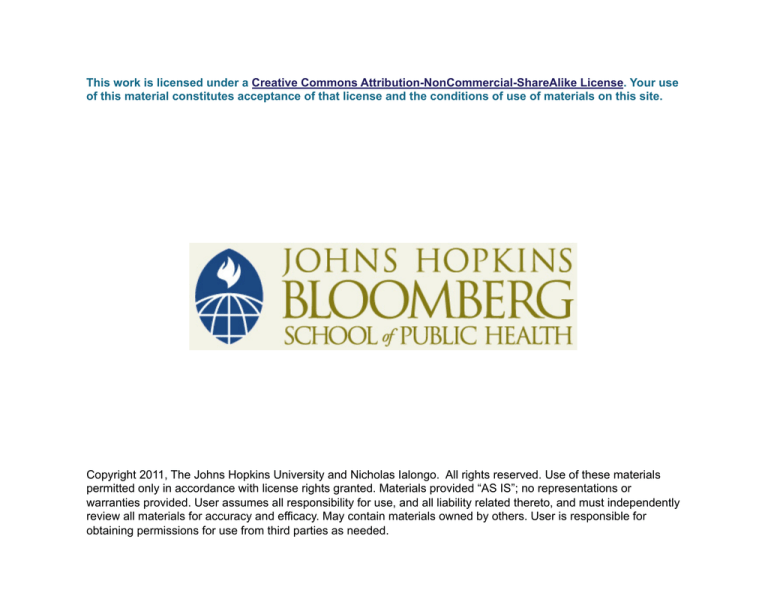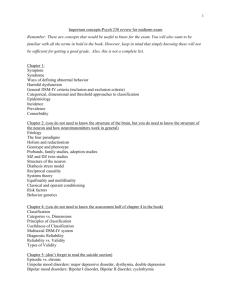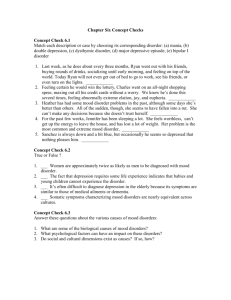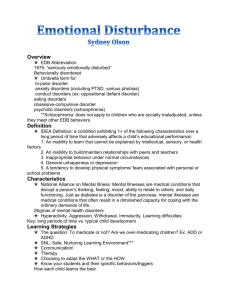
This work is licensed under a Creative Commons Attribution-NonCommercial-ShareAlike License. Your use
of this material constitutes acceptance of that license and the conditions of use of materials on this site.
Copyright 2011, The Johns Hopkins University and Nicholas Ialongo. All rights reserved. Use of these materials
permitted only in accordance with license rights granted. Materials provided “AS IS”; no representations or
warranties provided. User assumes all responsibility for use, and all liability related thereto, and must independently
review all materials for accuracy and efficacy. May contain materials owned by others. User is responsible for
obtaining permissions for use from third parties as needed.
Child Psychiatric Epidemiology
Nicholas Ialongo
November 15, 2010
Section A
Problems in Child Diagnosis and
Classification
Problems in Child Diagnosis and Classification
1. Adult disorders involve either declines from
attained levels of functioning or the onset of
pathognomic symptoms
2. Whereas childhood disorders involve a failure to
develop expected behaviors and/or quantitative or
situational deviance in behavior that most children
show in some degree
3. Unlike adults, children continually undergo major
changes in multiple spheres of functioning over
short time spans
Continued
4
Problems in Child Diagnosis and Classification
To help children need to facilitate
development rather than return to pre-morbid
functioning as with adults
Conditions that are normal at one time of life
may be pathological at another, for example:
Bedwetting at age two versus
bedwetting at age sixteen
School refusal presenting for the first
time in high school
Continued
5
Problems in Child Diagnosis and Classification
Must contend with the question of
distinguishing abnormality from normality in
both children and adults
However, with children, there is the added
problem of defining normality at different
developmental levels
Continued
6
Problems in Child Diagnosis and Classification
Children seldom seek help for themselves/
seldom have realistic conceptions of services
When brought for services, children do not
readily assume the role of patient and cannot
be relied on for the data typically provided by
adults
7
The Clinical Interview with the Adult
Definition/Parameters
The interactive medium
being one of vocal
communication
Which should entail more
or less full and voluntary
disclosure on the part of the
client/patient
Notes Available
Implied Demand on the
Adult
Acknowledgement of/
familiarity with vocal/verbal
exchange as a means of
problem resolution
Trust and confidence in the
expert
Continued
8
The Clinical Interview with the Child
Definition/Parameters
A dyadic interaction, wherein
one helping party doctor/
clinician is sincerely interested
in helping
The typically non-willing child
patient
The interactive medium being
one of indirect communication
(e.g., freeplay) or direct vocal
communication
Which should eventually entail
some degree of disclosure on the
part of the child patient
Notes Available
Implied Demand on the
Child
Recognition of doctor as an
agent of change
Self-attribution as “having
problems”
Acceptance of/familiarity with
indirect communication as a
means of problem resolution
Trust in the helping agent
9
Section B
Field Study Limitations
Sampling Framework
Clinic—in or outpatient
Non-clinic/community
Epidemiologic vs. nationally representative
Continued
11
Variations in Defining Psychopathology
Symptom
Syndrome
Disorder
Disorder—with or without impairment
12
Assessment Methods—Reporters
Parent
Child
Teacher
Clinician
13
Assessment Methods—Measures
Rating scales/checklists
Structured diagnostic interviews
Clinical observations
14
Reliability of Measurement
Age of onset
Between informants
Within informants over time
Variation in reliability by disorder
Children versus parents
Continued
15
Reliability of Measurement
Age of onset
Between informants
Within informants over time
Variation in reliability by disorder
Children versus parents
16
Issues Affecting Reliability
Child Characteristics
Age
Gender
Receptive vocabulary
Notes Available
Continued
17
Issues Affecting Reliability
Characteristics of the Questions
Length
Complexity
Unspecified time
Reflections of one’s own thoughts
Comparison of self with others
Notes Available
Continued
18
Issues Affecting Reliability
Results: Positive and Negative
19
Section C
Descriptive Epidemiology
Recent Studies
Methods for the Epidemiology of Child and
Adolescent Mental Disorders (MECA),
Shaffer, et al., J. of Am. Acad. Child
Adolescent Psychiatry (1996)
Great Smokey Mountain Study (GSMS),
Costello, et al., Arch Gen Psychiatry (1996)
21
MECA
Methods for the Epidemiology of Child and
Adolescent Mental Disorders (MECA)
Three communities in the Eastern U.S.
and Puerto Rico
Random probability household sample
of ~ 300 9-17-year-olds and their
parents from each site
DSM-III-R criteria as implemented
within the diagnostic interview schedule
for children 2.3—structured diagnostic
interview
22
Measures of Impairment
C-GAS
Diagnosis specific impairment criteria
23
Prevalence Rates with and without Diagnosis-Specific Impairment
Criteria (DSIC)
*Based on combined estimates of parental and youth’s report.
Notes Available
24
Prevalence Rates with and without Diagnosis-Specific Impairment
Criteria (DSIC)
*Based on combined estimates of parental and youth’s report.
Notes Available
25
Prevalence Rates with and without Diagnosis-Specific Impairment
Criteria (DSIC)
*Based on combined estimates of parental and youth’s report.
Notes Available
26
Prevalence Rates with and without Diagnosis-Specific Impairment
Criteria (DSIC)
*Based on combined estimates of parental and youth’s report.
Notes Available
27
Great Smokey Mountain Study
Longitudinal study of representative sample of
children and adolescents from predominantly
rural area in Southern Applachians drawn
from school registry
1,420 youths and parents at intake
Interviewed annually over four years
Notes Available
28
Sampling Design for the Great Smoking Mountains Study
Notes Available
29
Contents Areas and Instruments in GSMS
Source: Costello, et al. (1996), Arch Gen Psychiatry
30
Three Month Prevalence in the GSMS
Notes Available
Continued
31
Three-Month Prevalence in the GSMS
Notes Available
Continued
32
Three-Month Prevalence in the GSMS
Notes Available
33
Comorbidity in GSMS
Adapted from Costello, et al. (1996), Arch Gen Psychiatry
34
Correlates of Emotional Disorders in GSMS
Notes Available
35
Correlates of Behavioral Disorder in the GSMS
Notes Available
36
Potential Explanations for Comorbidity
Artifact of the classification system
One disorder causes another
Continued
37
Potential Explanations for Comorbidity
Artifact of the classification system
One disorder causes another
Common antecedents
The comorbid disorders—simply different
aspects of a single disorder
38
Section D
Attention Deficit Hyperactivity Disorder
Diagnostic Criteria for ADHD
Symptoms of inattention
1. Fails to attend to details or makes careless
mistakes
2. Has difficulty sustaining attention
3. Does not seem to listen when spoken to
4. Does not follow through on instructions or
duties
5. Has difficulty organizing tasks and activities
6. Dislikes and avoids tasks requiring
sustained mental
effort
7. Often loses things
8. Is distracted by extraneous stimuli
9. Is forgetful in daily activities
Continued
40
Diagnostic Criteria for ADHD
Symptoms of hyperactivity-impulsivity
1. Fidgets with hands or feet or squirms
2. Leaves seat inappropriately
3. Runs about or climbs inappropriately
4. Has difficulty playing quietly or in quiet
activities
5. Is often “on the go” as if driven “by a motor”
6. Talks incessantly
7. Blurts out answers before questions are
completed
8. Has difficulty awaiting turn
9. Interrupts or intrudes on others
Continued
41
Diagnostic Criteria for ADHD
Requirements for diagnosis
1. Predominantly Inattentive Type: 6 or
more symptoms in A
2. Predominantly Hyperactive-Impulsive
Type:
Six or more symptoms in B
3. Combined Type: Six or more symptoms
in A or B
4. Symptoms for at least six months with
onset before age seven
5. Symptoms occur in at least two settings
6. Impaired social, academic, or
occupational functioning
42
Associated Characteristics
Academic performance
On average, slightly lower intelligence
20-50% also have a learning disability
Lower achievement scores, school
grades, more likely to be held back,
and to be in special education
Serious emotional disturbance—a
school category used when child is
eligible for an IEP due to behavioral/
emotional problem only
Continued
43
Associated Characteristics
Peer and teacher relations
Judged negatively in peer nominations
(hyperactive rejected, inattentive
neglected)
Trouble making and keeping friends
Teachers more directive and controlling
Difficulty reading and interpreting social
cues
Continued
44
Associated Characteristics
Family relations
Parents more directive, intrusive, and
punitive
High levels of parental frustration, low
feelings of parenting efficacy
Marital problems
Injury/accidents
In childhood—higher rates of accidents
(23% ADHD vs. 15% controls)
In adolescence—higher rates of car
accidents, speeding, and drunk driving
45
Epidemiology
Overall prevalence rates—based on schoolage samples
1. In epidemiological samples—3-7%
2. In community samples—as high as
20%
3. Prevalence in preschool and
adolescence less well known
Higher prevalence among boys—two to nine
times more likely than girls
46
Epidemiology
Types of ADHD in order of prevalence
1. Inattentive type—most prevalent
2. Combined type—second most
common type seen in clinic samples
3. Hyperactivity/impulsivity subtype—
least prevalent
47
Theories to Explain ADHD
Motivational deficits
Lower sensitivity to reinforcement
Prefer immediate over distal rewards,
even if immediate rewards are smaller
Short-term (working) memory deficits
Holds incoming sensory information,
maintains it briefly, manipulates it, and
accesses long-term memory to do
something with it
Theory—ADHD people shift attention
rapidly to maintain sensory input
Continued
48
Theories to Explain ADHD
C. Deficits in self-regulation and inhibition
1. Theory only applies to hyperactive/
impulsive type
2. Self-regulation requires—ability to
inhibit impulses and to modulate
arousal
3. Frontal lobes are responsible for
behavioral inhibition
49
Etiology
Brain structure
1. Damage to frontal lobes
2. Abnormal electrophysiological
responding = underarousal
3. Deficiency in dopamine and
norepinephrine
Continued
50
Etiology
Genetics
1. 10-35% of parents and siblings of
ADHD
youth also have ADHD
2. Children of ADHD adults at greater
risk for
developing ADHD
3. Twin studies—heritability estimates =
.54–.89
4. ADHD appears to be dimensional
rather than categorical
Continued
51
Etiology
Pregnancy and birth complications
1. Premature and low birth-weight
babies at higher risk for attention
problems and impulsivity
2. Maternal smoking and alcohol use
3. Might be proxy variables for other
familial factors
Continued
52
Etiology
Diet—not substantiated
Lead poisoning—very small impact
Psychosocial—NOT primary causes but
central in maintaining/exacerbating disorder
53
Section E
Major Depressive Disorder
DSM IV Criteria
Major Depressive Disorder, defined as follows:
1. One or more depressive episodes
2. At least five symptoms present in
that episode (one of these must be *)
• A. *Depressed or irritable mood
• B. *Loss or interest or pleasure
• C. Change in weight or appetite
• D. Sleep problems
Continued
55
DSM IV Criteria
Major Depressive Disorder, defined as follows:
2. At least five symptoms present in that
episode (one of these must be *)
• E. Motor agitation or retardation
• F. Fatigue or loss of energy
• G. Feelings of worthlessness or guilt
• H. Difficulty thinking, concentrating, or
making decisions
• I. Thoughts of death or suicidal
behavior/thinking
3. Symptoms must be present for two weeks or
more
56
Epidemiology
1. Prevalence (at any given time):
a. Children: .4 - 2.5%
b. Adolescents: .4 – 8.8%
2. Lifetime prevalence (through age 18):
a. 35% of girls
b. 19% of boys
c. 28% overall
3. Gender differences not present before
adolescence; after that 2:1 girls : boys
Continued
57
Epidemiology
Comorbidity
40-70% have one other disorder
20-50% have more than one other
disorder
Most common—anxiety, disruptive
behavior, and substance abuse
Continued
58
Epidemiology
Developmental course
Infancy and preschool—lethargy,
feeding/sleep problems, irritability, sad
facial expressions
Middle childhood—prolonged periods of
depression evident, mixed anxiety/
depression, hopelessness/low self
esteem
Adolescence—begins to resemble adult
depression
59
Causes of Mood Disorders
A. Biochemistry
1. Norepinephrine Serotonin and
Depletion—low levels of norepinephrine
and/or serotonin (neurotransmitters) in the
brain due to: a.) too much reabsorption by
firing neuron and/or b.) breakdown of
norepinephrine and/or serotonin by enzymes
is too efficient
2. Dysregulation in neuroendocrine
system—connection between brain,
hormones, and organ systems
Continued
60
Causes of Mood Disorders
A. Biochemistry
2. Dysregulation in neuroendocrine
system
• Disturbances in the serotonin (5HT) system and the Limbic
Hypothalamic-Pituitary-Adrenal
(LHPA) axis have been
consistently associated with
mood disorders
Continued
61
Causes of Mood Disorders
A. Biochemistry
2. Dysregulation in neuroendocrine
system
• The limbic HPA axis (LHPA)
regulates arousal, sleep, appetite,
and the capacity to experience
and enjoy pleasure as well as the
control of mood
Continued
62
Causes of Mood Disorders
A. Biochemistry
2. Dysregulation in neuroendocrine
system
• Interaction between the serotonin
and LHPA systems may play a
significant role in etiology of
depression
• Cortisol interacts with serotonin 5HT receptors in the brain during
conditions of chronic stress
Continued
63
Causes of Mood Disorders
A. Biochemistry
2. Dysregulation in neuroendocrine
system
• Feedback mechanism is set in
motion through nerve connections
that link the hippocampus to the
LHPA
• Connections allow for receptors in
hippocampus to control both
hormonal and higher thinking
response to stress
Continued
64
Causes of Mood Disorders
A. Biochemistry
2. Dysregulation in neuroendocrine system
• Two types of receptors in the
hippocampus—Mineralocorticoid
Receptors (MR) and Glucocorticoid
Receptors (GR)
• Both types believed to work together to
control metabolism, blood cortisol levels,
and the LHPA
• Both believed to decrease stress,
hormone levels, and help defend against
the effects of stress
Continued
65
Causes of Mood Disorders
A. Biochemistry
2. Dysregulation in neuroendocrine
system
• Chronic stress associated with an
over-production of cortisol and
lowered levels of MR and GR in
hippocampus and prefrontal
cortex
• Lower levels of MR and GR
receptors may disrupt the
feedback mechanism
66
Causes of Mood Disorders
A. Biochemistry
3. Differences between children &
adults in terms of measures of . . .
• Basal cortisol secretion
• Corticotropin stimulation
• Postcorticotropin releasing
hormone (CRH) infusion
• Response to several serotonergic
probes
• And efficacy of tricyclic
medications
Continued
67
Causes of Mood Disorders
A. Biochemistry
4. Possible reasons for differences
between children and adults:
• 1.) Developmental factors
• 2.) Stage of illness factors (e.g.,
number of episodes, total
duration of illness), and/or
• 3.) Heterogeneity in clinical
outcome (e.g., recurrent unipolar
course vs. new-onset bipolar
disorder)
Continued
68
Causes of Mood Disorders
A. Biochemistry
5. Childhood stressors such as
maternal separation appear to result in
lasting effects on stress-responsive
neurobiological systems, including the
LHPA axis and noradrenergic systems
and the hippocampus
• Clinical studies of patients with a
history of child abuse also
implicate dysfunction in the LHPA
axis and the noradrenergic and
hippocampal systems
Continued
69
Causes of Mood Disorders
B. Genetics—moderate for MDD, recent
evidence of gene x environment interaction
A functional polymorphism in the
promoter region of the serotonin
transporter (5-HTT) gene Caspi, et al.,
Science, 2003
Continued
70
Causes of Mood Disorders
Thinking style
Cognitive distortions
• Catastrophize—fear the worst
• Overgeneralize—this bad thing happens
all the time everywhere
• Personalize—this bad thing is happening
only to me/because of me
• Selective attention to negative events
Learned helplessness—repeated failed attempts
to control negative circumstances leads to feeling
of powerlessness
71
Causes of Mood Disorders
Thinking style
Attributional style—internal, stable, and
global attributions for failures (negative
events is associated with depression)
Hopelessness theory of depression—
negative attributional style (diathesis)
coupled with negative life events (stress)
Self-control model—selectively attend to
negative events, set overly stringent selfevaluation criteria, provide little positive
self-reinforcement and excessive selfpunishment
72






